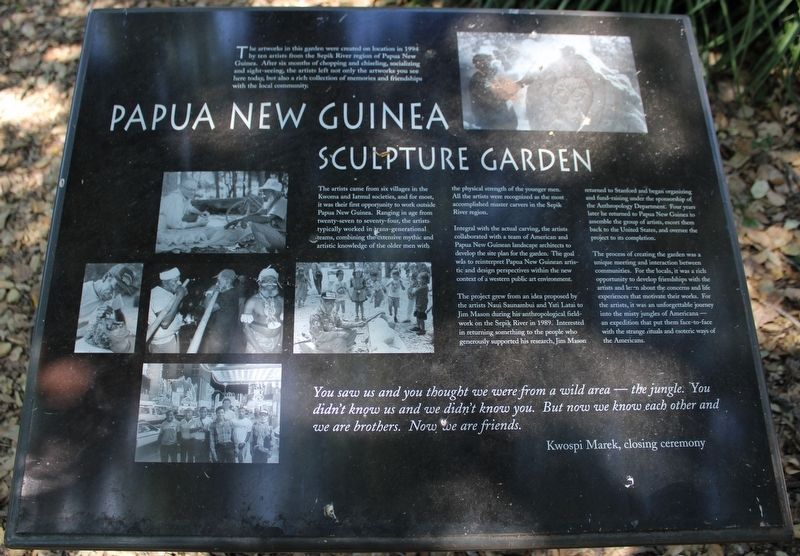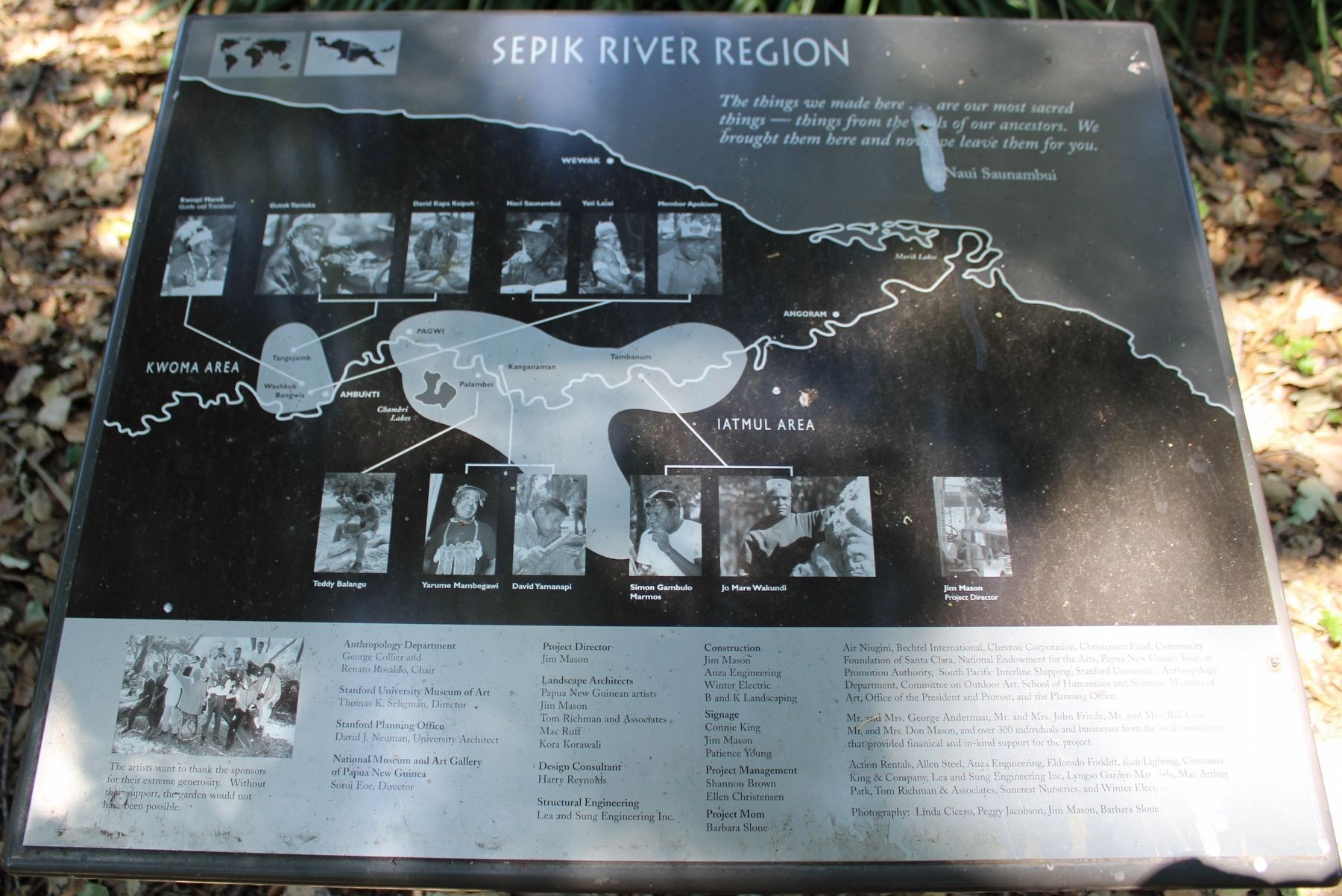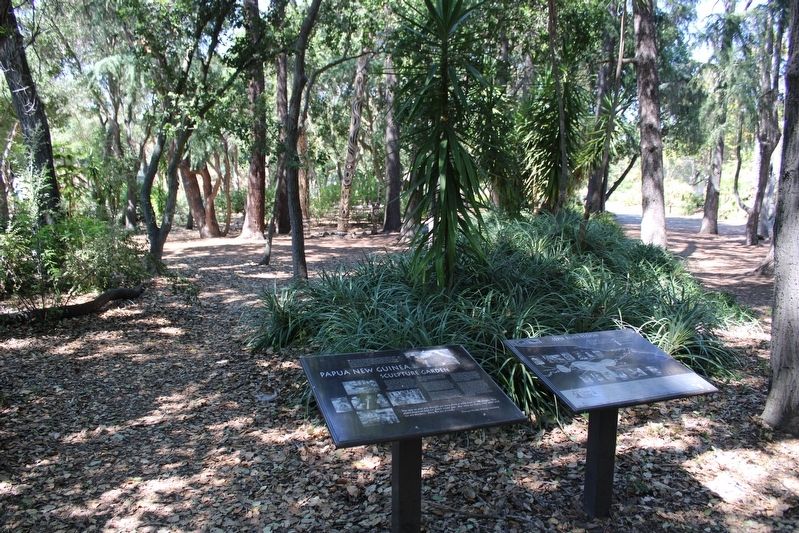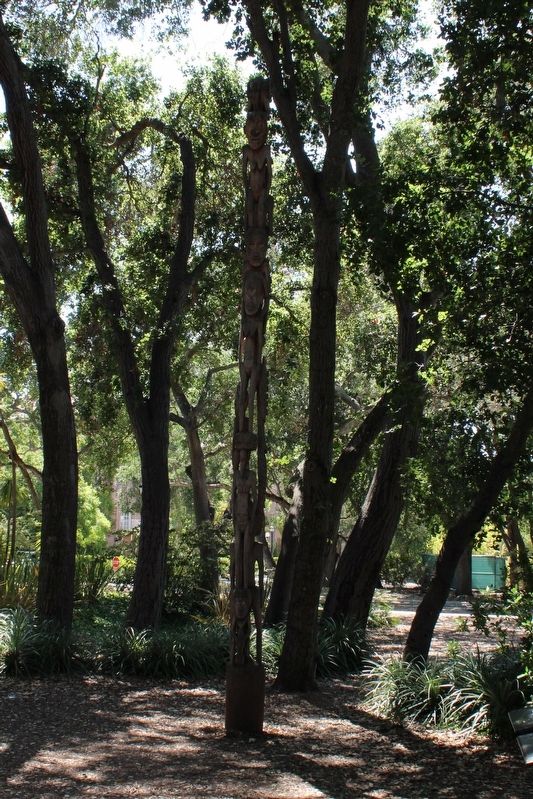Stanford in Santa Clara County, California — The American West (Pacific Coastal)
Papua New Guinea Sculpture Garden
The artists came from six villages in the Kwoma and Iatmul societies, and for most, it was their first opportunity to work outside Papua New Guinea. Ranging in age from twenty-seven to seventy-four, the artists typically worked in trans-generational teams, combining the extensive mythic and artistic knowledge of the older men with the physical strength of the younger men. All the artists were recognized as the most accomplished master carvers in the Sepik River region.
Integral with the actual carving, the artists collaborated with a team of American and Papua New Guinean landscape architects to develop the site plan for the garden. The goal was to reinterpret Papua New Guinean artistic and design perspectives within the new context of a western public art environment.
The project grew from an idea proposed by the artists Naui Saunambui and Yati Latai to Jim Mason during his anthropological fieldwork on the Sepik River in 1989. Interested in returning something to the people who generously supported his research, Jim Mason returned to Stanford and began organizing and fund-raising under the sponsorship of the Anthropology Department. Four years later he returned to Papua New Guinea to assemble the group of artists, escort them back to the United States, and oversee the project to its completion.
The process of creating the garden was a unique meeting and interaction between communities. For the locals, it was a rich opportunity to develop friendships with the artists and learn about the concerns and life experiences that motivate their works. For the artists, it was an unforgettable journey into the misty jungles of Americana - an expedition that put them face-to-face with the strange rituals and esoteric ways of the Americans.
You saw us and you thought we were from a wild area - the jungle. You didn't know us and we didn't know you. But now we know each other and we are brothers. Now we are friends.
Kwospi Marek, closing ceremony
Erected by Stanford University.
Topics. This historical marker is listed in these topic lists: Anthropology & Archaeology • Arts, Letters, Music • Education. A significant historical year for this entry is 1989.
Location. 37° 25.491′ N, 122° 10.423′ W. Marker is in Stanford, California, in Santa
Clara County. Marker is at the intersection of Lomita Drive and Santa Teresa Street, on the right when traveling south on Lomita Drive. The resin marker is mounted to a metal post in the garden. Touch for map. Marker is at or near this postal address: 476 Lomita Drive, Stanford CA 94305, United States of America. Touch for directions.
Other nearby markers. At least 8 other markers are within walking distance of this marker. Nourishing the Whole Student (within shouting distance of this marker); Exploring the Forces of Nature (about 800 feet away, measured in a direct line); The Stanford Women’s Clubhouse (approx. 0.2 miles away); Generations of Diverse Perspectives (approx. ¼ mile away); First Inhabitants: The Ohlone of the Peninsula (approx. ¼ mile away); In Pursuit of Breakthroughs (approx. ¼ mile away); A Road Well Traveled (approx. ¼ mile away); Welcome to the Stanford Clock Tower (approx. ¼ mile away). Touch for a list and map of all markers in Stanford.
Also see . . .
1. Papua New Guinea Sculpture Garden. Atlas Obscura
"Comprised of more than 20 sculpted poles featuring patterns and figures of a New Guinean design, multiple standing figures, carved drums, and other assorted works, the garden is a stark contrast to the surrounding architecture."(Submitted on September 3, 2023, by Joseph Alvarado of Livermore, California.)
2. What You Don’t Know About the Papua New Guinea Sculpture Garden. Stanford Magazine
"The ambitious project involved the transportation from Papua New Guinea of nearly 40-foot-long kwila and garamut tree trunks chosen by the artists. The project would flip the script on the anthropological practice of going to another country to study a different culture..."(Submitted on September 3, 2023, by Joseph Alvarado of Livermore, California.)
Credits. This page was last revised on September 3, 2023. It was originally submitted on September 3, 2023, by Joseph Alvarado of Livermore, California. This page has been viewed 51 times since then and 9 times this year. Photos: 1, 2, 3, 4. submitted on September 3, 2023, by Joseph Alvarado of Livermore, California.



